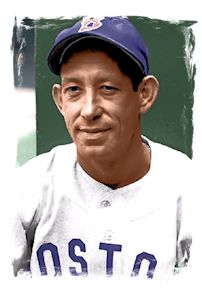 |
Mike Guerra was born on October 11, 1912, in Havana, Cuba. He was illiterate and raised in poverty and may have attended primary school for six years. He began in baseball playing in the Cuban capital’s empty lots, and then as a batboy at Havana’s Almendares Park. As a small boy, he made his living selling fruit and vegetables from a basket in the Plaza del Vapor, the huge Havana market, but fortunately found himself able to make a little something playing semipro baseball for Acción Cubana. He started his professional career well before the war, late in 1934 and after the first of the two revolutions which bracketed his baseball career. In November, the 1934-35 Cuban League season began, and Mike was the main catcher on the Habana Reds. The Senators made him among their first of many Cuban signings. He trained with Washington in the spring of 1936 and was transferred to Albany before the spring was over. He spent most of 1937 playing for the Salisbury Indians, a Class D team in the Eastern Shore League affiliated with Washington. The fleet-footed Mike was named the All-Star catcher for the league and he debuted with the Senators in September. That winter, Mike returned to Cuba, catching for Marianao. Then he was back with Salisbury, for 19 games, in 1938 and hit .323, also playing a couple of games in Class B with the Charlotte Hornets, too. In the winter of 1938-39, he was back with Almendares in Cuba. He got in a much fuller season in 1939, in Class B South Atlantic League ball playing for the Greenville Spinners and hitting .321. Another big-league club traveled to Cuba in the spring of 1941, and this time it was the Brooklyn Dodgers, who learned first-hand that the Cubans could be difficult opponents. One month later, Mike was called up to Washington. During his five years with the Washington organization, he intermittently returned to Cuba going AWOL. Even so, the Senators still didn’t cut ties with him. He played for Almendares again in winter ball and spent the summer of 1942 with the Chattanooga Lookouts, Washington’s Class A-1 team. With World War II underway and teams training closer to home during the spring of 1943, there were no visits to the island by American players, but Mike was once more the All-Star catcher in Cuban League play. Playing in the U.S. wasn’t always easy for him. Even though he was of “white” ancestry, he was still Latino and a target of barbs from other ballplayers and the object of quite a bit of bench-jockeying, much of it racial. He did not played in the United States during the 1943 season, but in 1944 it looked like was going to pay off for Washington. Cubans were not subject to the military draft while playing in the US and Mike got into 75 big-league games in, hitting .281. In 1945, he joined the team in mid-March and was Rick Ferrell’s understudy, but his average dropped off all the way down to .210. He played the 1946-47 season for the Oriente ballclub (managing it as well) in the Liga de la Federación, a separate entity from the Cuban League. The Senators didn’t know if Mike was coming back or not for the ’46 season. In December 1946, after nearly 10 years in the Senators system, he was sold on waivers to the Philadelphia Athletics. In 1947, Mike hit .215 for Philadelphia, backing up Buddy Rosar. In 1948, he played in fewer games and hit .211, again. Before the 1948-49 season, an agreement had been reached between the Cuban League and Organized Baseball. He had a much better year for the Athletics in 1949, hitting .265 in 98 games. He was the Most Valuable Player for 1949-50 Cuban League baseball, as player-manager for the Almendares Blues, hitting .304 and helping lead his team to the flag. Mike didn’t start the season playing, but once the ban on U.S. major leaguers playing for Cuban teams was lifted, he assigned himself the role as the team’s catcher. He had another strong year for Philadelphia in 1950, batting for a .282 average. In December the Boston Red Sox sold catcher Birdie Tebbetts to the Indians and bought Mike from the A’s. As it turned out, though, the Red Sox catcher for 1951 was Les Moss, who came from the Browns in May and handled most of the work and the Senators bought Mike. 1951 was his final season in major-league baseball., accumulating 231 plate appearances and hitting .201. On the first day of 1952, Mike got the job he wanted most, manager of the Havana Cubans, the Florida International League farm team of the Nats. He wasn’t finished playing baseball, however. For the 1952-53 Cuban League season, Almendares replaced him as manager and Mike became manager with the Marianao Tigers, gathering another 173 at-bats. He next turned up as manager for Habana for three seasons, 1958/59 through 1960/61. After his active career was over, he worked as a full-time scout for the Detroit Tigers from 1960 through 1962. Mike Guerra was elected to the Cuban Baseball Hall of Fame in 1969 and passed away at age 79, after a long struggle with heart disease, on October 9, 1992, in Miami Breach. |
|||||
